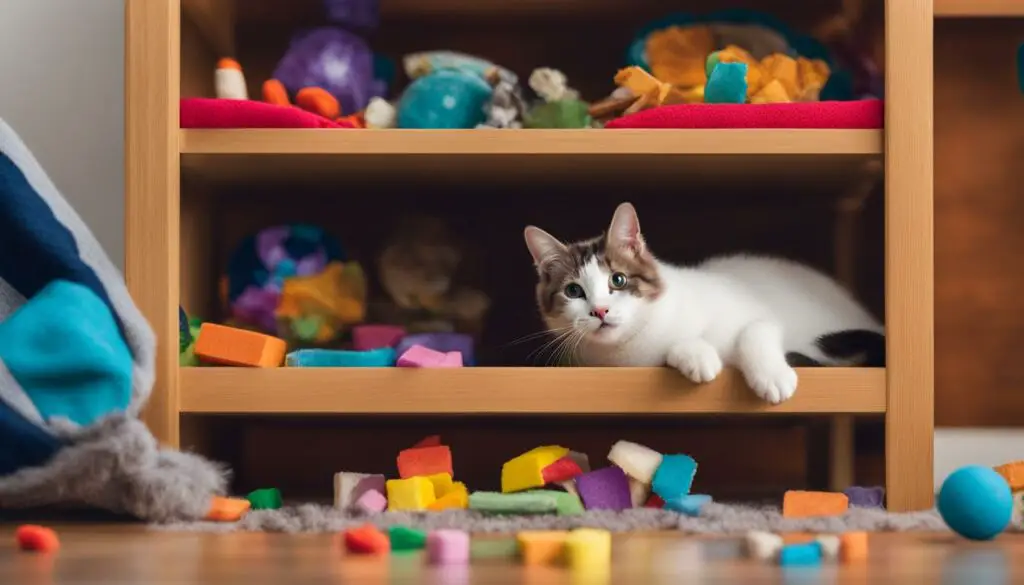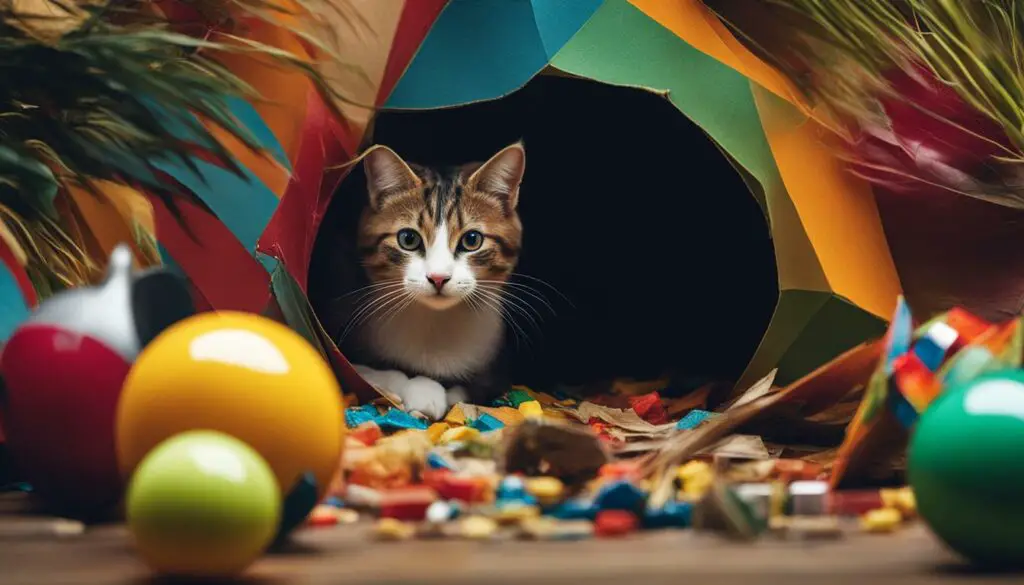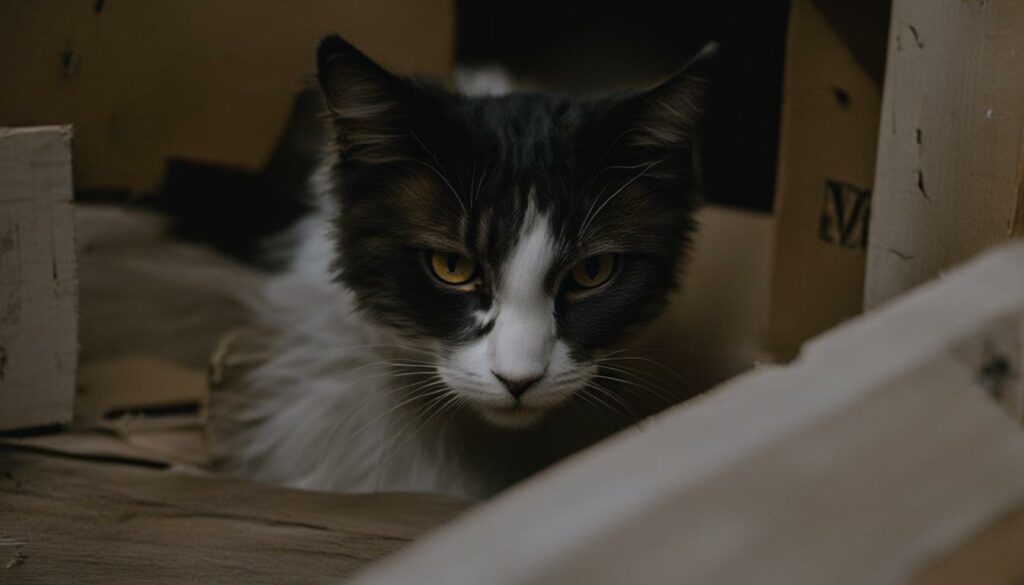Are you a new cat owner who is growing increasingly frustrated because your furry friend is still hiding, even after a month? You’re not alone. Many new cat owners experience this behavior, and it can be attributed to various factors, such as fear, anxiety, and the need for a proper adjustment period.
Understanding cat behavior and implementing appropriate strategies can help your cat feel more comfortable and secure in their new home. In this article, I will guide you through the basics of cat behavior, the importance of gradual exposure, creating a comforting space, and building trust with your new cat.
Key Takeaways:
- Many new cat owners experience the frustration of their cat hiding for extended periods, even after a month.
- Understanding cat behavior is crucial in deciphering their needs and emotions.
- Gradual exposure and positive reinforcement techniques can help your cat feel more at ease.
- Creating a comforting space with hiding spots and environmental enrichment is important for reducing stress.
- Gradual introductions and socialization can help your cat build positive relationships with family members and other pets.
Understanding Cat Behavior and Hiding Patterns
When bringing a new cat into your home, it’s important to understand their behavior and the reasons behind their hiding patterns. Cats are naturally territorial and solitary animals, and hiding is a common instinctive response to potential threats or unfamiliar surroundings. By observing their body language and vocalizations, you can gain insights into their level of fear and anxiety.
Body language plays a significant role in understanding cat behavior. Signs of fear may include a lowered body posture, flattened ears, dilated pupils, and a swishing tail. On the other hand, signs of relaxation and contentment include a relaxed body posture, slow blinking, and gentle grooming. Vocalizations such as hissing, growling, or excessive meowing can also indicate fear or discomfort.
It’s important to note that cats may have individual variations in their behavior and hiding patterns. Some cats may hide for a few hours or days when faced with new surroundings, while others may take longer to feel comfortable. By understanding your cat’s unique behavior, you can tailor your approach to help them adjust at their own pace.
In addition to body language and vocalizations, the territorial nature of cats should also be considered. Cats have a strong need to establish their territory and may choose hiding spots to claim as their own. Providing them with designated hiding areas, such as cozy beddings or cat trees, can help fulfill their instinctual needs while making them feel more secure in their new environment.
| Behavior | Signs |
|---|---|
| Fear | Lowered body posture, flattened ears, dilated pupils, swishing tail |
| Relaxation | Relaxed body posture, slow blinking, gentle grooming |
| Territoriality | Choosing hiding spots to claim as their own |
Understanding cat behavior and their nonverbal cues is crucial in deciphering their needs and emotions. By providing a safe and comfortable environment, respecting their need for personal space, and gradually introducing them to new experiences, you can help your new cat feel more at ease and reduce their hiding behavior over time. Remember to be patient and allow them to acclimate at their own pace, as each cat will have their own unique adjustment period.

The Importance of Gradual Exposure and Positive Reinforcement
When bringing a new cat into your home, it’s important to understand that they may need time to adjust to their new environment. Gradual exposure and positive reinforcement are key strategies in helping your cat feel comfortable and build trust.
Patience is crucial during this process. Allow your cat to explore their surroundings at their own pace. Provide them with a designated safe space where they can retreat to when they feel overwhelmed or anxious.
Implementing positive reinforcement techniques can also help in building trust and creating a positive association with their new home. Reward your cat with treats or praise when they exhibit brave behavior or show interest in their surroundings. This encourages them to explore further and helps them feel more secure.
Remember, every cat is unique and will require different amounts of time and support to feel fully acclimated. By gradually exposing them to their new home and using positive reinforcement, you can help your cat feel more at ease and confident in their new surroundings.

The Benefits of Gradual Exposure
| Benefits | Explanation |
|---|---|
| Reduced Stress | Gradual exposure allows your cat to adapt to new stimuli without feeling overwhelmed, resulting in reduced stress levels. |
| Increased Confidence | As your cat becomes more familiar with their surroundings through gradual exposure, their confidence will grow, leading to a more confident and relaxed demeanor. |
| Established Boundaries | Gradual exposure helps your cat understand their new home’s boundaries, allowing them to feel more secure and comfortable. |
| Improved Bonding | By taking the time to gradually expose your cat to their new environment, you can establish a stronger bond and trust between you and your feline companion. |
Gradual exposure and positive reinforcement are essential in helping a new cat feel comfortable and secure in their new home.”
– Feline Behavior Expert
Creating a Comforting Space for Your Cat
When bringing a new cat into your home, it’s essential to create a comforting space that helps them feel safe and secure. Environmental enrichment plays a crucial role in reducing stress and promoting a positive adjustment period. Here are some key elements to consider:
Hiding Spots: Cats naturally seek out hiding spots as a means of feeling protected. Provide various hiding spots throughout your home, such as cozy cat caves, covered beds, or even cardboard boxes with comfortable bedding inside. These hiding spots give your cat a sense of security and ownership over their personal space.
Comfort Zone: Identify an area in your home where your cat feels most comfortable and establish it as their designated comfort zone. This can be a spare room or a specific corner with their bed, litter box, food, and water bowls. By having a dedicated space, your cat will have a safe retreat they can retreat to when they feel overwhelmed or stressed.
| Benefits of Creating a Comforting Space for Your Cat |
|---|
| Reduces stress and anxiety |
| Promotes a sense of security and ownership |
| Helps with territorial adjustment |
| Provides a safe retreat for your cat |
Pheromones: Pheromones are chemical signals that cats use to communicate and establish a sense of familiarity in their environment. Using pheromone diffusers or sprays, such as Feliway, can help create a calming atmosphere and reduce stress for your cat. These products mimic the natural pheromones that cats produce when they feel safe and content, helping to reassure them in their new surroundings.
By incorporating these environmental enrichment techniques into your home, you can create a comforting space that promotes relaxation and reduces stress for your new cat. Remember to observe your cat’s behavior and make adjustments accordingly to ensure their well-being and comfort.
Gradual Introductions and Socialization
Socialization is a crucial aspect of helping your new cat feel comfortable and secure in their new environment. Gradually introducing your cat to family members and other pets, if applicable, can pave the way for positive relationships and reduce their tendency to hide. By utilizing social cues and building trust through gentle interactions, you can create a welcoming atmosphere for your furry friend.
When introducing your cat to new individuals, it’s important to approach the process with patience and understanding. Allow your cat to set the pace, giving them the opportunity to approach and explore on their terms. This gradual approach can help alleviate their fear and anxiety, allowing them to feel more at ease in their new surroundings.
During these introductions, observe your cat’s body language for signs of comfort or distress. Look for relaxed postures, slow blinks, and purring, as these are indications that your cat is feeling more secure. Conversely, watch for signs of tension, such as flattened ears or hissing, which may suggest that your cat needs more time and space to adjust.
Gradual Introductions and Socialization Tips:
- Allow your cat to explore new spaces at their own pace.
- Use gentle, positive interactions to build trust and bond.
- Provide separate spaces and resources for multiple cats.
- Supervise interactions between your cat and other pets, especially during the initial stages.
- Offer treats and rewards to reinforce positive experiences during socialization.
Remember, every cat is unique and may require different levels of socialization. Be patient, consistent, and create a supportive environment that encourages your cat to come out of their hiding place and engage with their new surroundings.
| Benefits of Gradual Introductions and Socialization | Key Strategies |
|---|---|
| Builds trust and positive relationships | Allow your cat to approach new individuals at their own pace |
| Reduces fear and anxiety | Use social cues like slow blinks and gentle interactions |
| Promotes a harmonious multi-pet household | Supervise interactions and provide separate spaces for multiple cats |
| Encourages exploration and confidence | Reward positive experiences with treats and praise |
By implementing gradual introductions and socialization techniques, you can help your new cat feel more at home and confident in their surroundings. Remember, building trust takes time, so be patient and supportive throughout this process. Your efforts will be rewarded with a stronger bond and a happier, more social cat.

Play Therapy and Calming Techniques
Engaging in play therapy with your new cat can have numerous benefits, both for their physical and mental well-being. Play sessions provide an outlet for them to release pent-up energy and stimulate their natural instincts. It also helps in building a strong bond and trust between you and your cat. Incorporating calming techniques further enhances the effectiveness of play therapy, promoting relaxation and reassurance.
| Play Therapy | Calming Techniques |
|---|---|
| Engage in interactive play sessions using toys such as feather wands or laser pointers. This not only provides physical exercise but also promotes mental stimulation. | Utilize soothing music or ambient sounds to create a calm environment for your cat. This can help reduce anxiety and create a sense of tranquility. |
| Rotate toys regularly to keep play sessions exciting and prevent boredom. Incorporate puzzle toys or treat-dispensing toys to stimulate their problem-solving skills. | Consider using desensitization techniques to gradually expose your cat to triggers that may cause fear or anxiety. This can be done by introducing the trigger at a low intensity and gradually increasing it over time. |
| Engage in interactive play sessions using toys such as feather wands or laser pointers. This not only provides physical exercise but also promotes mental stimulation. | Utilize soothing music or ambient sounds to create a calm environment for your cat. This can help reduce anxiety and create a sense of tranquility. |
“Play therapy is an essential tool in helping your new cat adjust to their surroundings. It allows them to engage in natural behaviors and establish a bond with you,” says feline behavior expert, Dr. Jane Smith.
During play sessions, observe your cat’s body language and adjust the intensity of play accordingly. Some cats may prefer gentle play, while others may enjoy more active play. It’s important to respect their individual preferences and provide a safe and positive playing environment.
Additionally, incorporating calming techniques can help your cat feel more secure and relaxed. This can be especially beneficial during the initial adjustment period when they may be more prone to anxiety and fear. By combining play therapy and calming techniques, you can create a harmonious environment that promotes bonding, reassurance, and overall well-being for your new cat.
Understanding Hiding Triggers and Patterns
When your new cat continues to hide after a month, it’s important to identify the triggers and patterns that contribute to their fearful behavior. By closely observing their actions and environment, you can gain valuable insights into what causes them stress and fear. This understanding will allow you to implement effective strategies to help your cat feel more secure and comfortable in their new home.
Stress is a common factor that can lead to hiding behavior in cats. It’s essential to pay attention to any changes or potential stressors in their environment, such as loud noises, frequent visitors, or sudden changes in routine. By minimizing these stressors, you can create a calmer atmosphere that promotes relaxation and reduces the need for hiding.
Observation is key when deciphering your cat’s hiding triggers and patterns. Take note of their body language, vocalizations, and any specific events that coincide with their hiding behavior. This information will help you pinpoint the specific triggers that cause fear and anxiety in your cat, enabling you to address them effectively.
Remember, every cat is unique, and their hiding triggers may vary. Patience and careful observation will guide you in understanding your cat’s individual needs and preferences, allowing you to provide them with the support and reassurance they require.

| Hiding Triggers | Common Signs of Fear |
|---|---|
| 1. Loud noises | 1. Ears flattened against the head |
| 2. Sudden changes in environment | 2. Tail tucked between the legs |
| 3. Unfamiliar people or animals | 3. Dilated pupils |
| 4. Lack of hiding spots | 4. Hissing or growling |
The table above provides examples of common hiding triggers and the corresponding signs of fear displayed by cats. By recognizing these triggers and signs, you can take proactive measures to minimize their impact and create a more comfortable environment for your feline friend.
Patience and Gradual Acclimatization
A new cat that continues to hide after a month requires patience and gradual acclimatization to their new surroundings. Each cat has their own unique personality and adjustment timeline, so it’s important to respect their cautiousness and allow them to feel comfortable at their own pace.
Creating a safe and secure space for your cat is crucial during this acclimatization period. Provide them with a designated area where they can retreat and feel protected. This could be a cozy bed, a quiet corner, or even a cat tree with hiding spots. Having a safe space will help them build trust and gradually feel more confident in exploring their surroundings.
During this time, it’s essential to avoid rushing or forcing interactions with your cat. Instead, let them approach you at their own volition. Offer gentle and patient interactions, such as softly speaking to them or offering treats, to help establish a positive association with your presence. Slowly introduce new experiences and people, always considering their cautiousness and need for a gradual integration process.
Seeking Professional Assistance
If your cat’s hiding behavior persists and shows no signs of improvement, it may be beneficial to seek professional assistance from a behavior consultant or veterinarian specializing in feline behavior. These professionals have the expertise and knowledge to assess your cat’s behavior, identify underlying issues, and develop a customized behavior modification plan.
Professional behavior consultants will often begin by conducting a thorough observation of your cat’s behavior, taking note of the triggers and patterns that contribute to their hiding. They will also assess your cat’s overall well-being, including their physical health and environment. Based on their findings, a behavior consultation will be tailored to address your cat’s specific needs.
During a behavior consultation, the consultant will provide guidance and recommendations on how to modify your cat’s behavior and create a more comfortable and secure environment. They may suggest strategies such as gradual exposure, desensitization techniques, or the use of positive reinforcement to help your cat overcome their fear and anxiety.
Remember that seeking professional assistance does not mean you have failed as a cat owner. It simply demonstrates your commitment to providing the best care for your furry companion. With expert guidance and support, you can work towards helping your cat feel more confident, secure, and ultimately lead a happier and healthier life.

Table: Sample Behavior Modification Strategies
| Strategy | Description |
|---|---|
| Gradual Exposure | Introduce your cat to new environments and experiences gradually, allowing them to adjust at their own pace. |
| Desensitization Techniques | Gradually expose your cat to triggers or stimuli that cause them to hide, helping them build tolerance and reduce fear. |
| Positive Reinforcement | Reward your cat with treats, praise, or playtime when they exhibit more confident and sociable behavior. |
| Environmental Enrichment | Create a stimulating and comfortable environment for your cat with hiding spots, interactive toys, and soothing pheromones. |
Remember, every cat is unique, and what works for one may not work for another. Patience, consistency, and a commitment to finding the right approach are key to helping your cat overcome their hiding behavior.
Creating a Stress-Free Environment
Creating a stress-free environment for your new cat is essential in helping them feel safe and secure in their new home. By minimizing potential stressors and providing familiar scents and a consistent routine, you can greatly contribute to their overall well-being.
To reduce environmental stimuli that may cause stress, it’s important to identify and address any potential triggers. This could include loud noises, sudden changes, or excessive activity in the household. Creating a calm and peaceful atmosphere can help your cat feel more relaxed and at ease.
In addition, incorporating familiar scents into your cat’s environment can provide a sense of comfort and familiarity. This can be done by using items such as blankets, beds, or toys that carry the scent of their previous home or the shelter they came from. Familiar scents can help alleviate anxiety and promote a sense of security.
Establishing a consistent routine is also crucial in creating a stress-free environment for your cat. Cats thrive on predictability, so providing them with regular feeding times, play sessions, and quiet periods for relaxation can help reduce stress and anxiety. Consistency in their daily routine helps them feel more in control and less likely to hide or exhibit fearful behavior.
| Stress Reduction Techniques | Benefits |
|---|---|
| Minimize environmental stimuli | Reduces potential stressors in the cat’s environment |
| Incorporate familiar scents | Provides a sense of comfort and security |
| Establish a consistent routine | Reduces anxiety and promotes a sense of control |
Creating a stress-free environment is crucial in helping your new cat feel safe and secure. By minimizing potential stressors, incorporating familiar scents, and establishing a consistent routine, you can greatly contribute to their overall well-being and happiness.
Remember, every cat is unique, so it may take some trial and error to find what works best for your furry friend. Pay attention to their behavior and adjust your approach accordingly. By creating a stress-free environment, you are providing your cat with the foundation they need to thrive in their new home.

Now that you’ve learned about creating a stress-free environment, the next section will focus on encouraging exploration and curiosity in your new cat.
Encouraging Exploration and Curiosity
When it comes to helping your new cat feel more at ease and less inclined to hide, encouraging exploration and curiosity is key. By providing opportunities for gradual habituation to new areas of your home and offering interactive toys, you can stimulate their natural instincts and promote a sense of adventure.
Gradual habituation allows your cat to become familiar with different spaces at their own pace. Start by introducing them to one room at a time, ensuring they have a safe hiding spot where they can retreat if needed. As they become more comfortable, gradually open up access to other rooms, giving them the freedom to explore and discover new environments.
Interactive toys are a great way to engage your cat’s curiosity and provide mental stimulation. Choose toys that encourage play and mimic the hunting instincts of a cat, such as puzzle feeders or treat-dispensing toys. These toys not only keep your cat entertained but also help build their confidence and alleviate boredom.
Remember, patience is key throughout this process. Allow your cat to explore and interact with their surroundings at their own pace, providing gentle encouragement and rewards for their curiosity. By creating an environment that promotes exploration and curiosity, you can help your new cat overcome their hiding behavior and foster a sense of adventure in their new home.

Tips for Encouraging Exploration and Curiosity:
- Start with gradual habituation to new areas of your home, opening up access to new rooms as your cat becomes more comfortable.
- Provide interactive toys that stimulate your cat’s natural instincts and provide mental stimulation.
- Be patient and give your cat space to explore and interact with their surroundings at their own pace.
- Offer gentle encouragement and rewards for their curiosity to build their confidence.
The Role of Communication and Trust Building
Establishing effective communication with your cat is essential in gaining their trust and helping them feel more comfortable in their new environment. Understanding their body language and vocalizations can provide valuable insights into their emotions and needs.
When it comes to communication, pay close attention to your cat’s body language. Is their tail upright and relaxed, or tucked between their legs? Are their ears erect or flattened against their head? These subtle cues can indicate their level of comfort or distress. Additionally, observe their vocalizations. Are they purring softly or growling and hissing? Each vocalization carries a specific meaning, so take the time to learn and respond appropriately.
Positive interactions are key to building trust with your cat. Approach them calmly and slowly, allowing them to initiate physical contact if they feel comfortable. Use gentle strokes and offer treats or toys as rewards for their cooperation. Remember, trust takes time, so be patient and let your cat set the pace for bonding.
In addition to nonverbal cues and positive interactions, consider using pheromone diffusers or sprays to create a soothing and reassuring atmosphere for your cat. Feline-specific pheromones, such as those found in products like Feliway, can help reduce anxiety and promote a sense of security.
Overall, effective communication and trust building are essential components of helping your new cat feel safe and secure in their environment. By understanding their body language and vocalizations, engaging in positive interactions, and utilizing pheromone aids, you can strengthen your bond and create a harmonious living environment for both you and your feline companion.

Feline Comfort Aids – Pheromones and Calming Products
When it comes to helping your new cat feel calm and secure in their new home, feline-specific comfort aids can play a crucial role. Two popular options are pheromones and calming products, which can provide stress reduction and reassurance for your furry friend.
Pheromones: Feline pheromones are natural chemical signals that cats use to communicate with one another. These pheromones help create a calming and reassuring atmosphere, making your cat feel more at ease. One well-known pheromone product is Feliway, which comes in various forms such as diffusers, sprays, and wipes. Feliway mimics the facial pheromone that cats release when they rub their faces against objects, signaling a safe and familiar environment. By using Feliway, you can help reduce your cat’s stress levels and promote a sense of comfort.
Calming Products: In addition to pheromones, there are various calming products available on the market that can aid in reducing stress and providing reassurance for your cat. These can include herbal supplements, diffusers, sprays, or even calming collars. The active ingredients in these products vary, but they typically include natural substances known for their calming properties, such as chamomile or lavender. Before introducing any calming products to your cat, it’s important to consult with your veterinarian to ensure they are safe and suitable for your cat’s individual needs.
The Benefits of Feline Comfort Aids
- Promote relaxation and reduce anxiety levels in cats.
- Help create a calming and reassuring environment.
- Assist in reducing stress during times of change or adjustment.
- Aid in establishing a sense of security and comfort for your cat.
Using feline-specific pheromones and calming products can be an effective way to support your cat’s emotional well-being and help them feel more at ease in their new surroundings. It’s important to choose high-quality products and consult with your veterinarian to ensure you are using the right options for your cat’s specific needs. Remember, each cat is unique, and what works for one may not work for another. By providing these comfort aids, you can help create a peaceful and stress-free environment that allows your cat to thrive.

| Product | Type | Features |
|---|---|---|
| Feliway | Pheromone | Available in diffusers, sprays, and wipes; mimics facial pheromones; promotes a sense of safety and familiarity |
| Calming Collar | Calming Product | Worn around the neck; releases calming substances; provides continuous comfort |
| Herbal Supplements | Calming Product | Natural ingredients with calming properties; available in various forms such as treats or liquids |
Remember, it’s important to combine the use of feline comfort aids with other strategies, such as gradual exposure and positive reinforcement, to help your cat feel more comfortable and secure. By providing a calm and reassuring environment, you can support your cat’s emotional well-being and help them adjust to their new home.
Monitoring Hiding Duration and Progress
As a new cat owner, it’s important to continuously monitor your cat’s hiding duration and progress to ensure their well-being and adjustment to their new environment. While some cautiousness is normal during the adjustment period, prolonged hiding or extreme fear may indicate the need for reassessment and possible modifications to your strategies.
One effective way to monitor your cat’s hiding duration is by keeping a daily record. Note the amount of time your cat spends hiding, as well as any triggers or patterns that seem to influence this behavior. By tracking these details over time, you’ll be able to identify any changes or improvements in their hiding habits.
Additionally, observe your cat’s body language and behavior when they are out of hiding. Are they becoming more comfortable and exploring their surroundings? Do they show signs of relaxation and contentment? Pay attention to their overall progress and gradual integration into their new home.
If you find that your cat’s hiding duration is not improving or they continue to display extreme fear and anxiety, it may be necessary to reassess your strategies and seek professional assistance. A behavior consultant or veterinarian specializing in feline behavior can provide expert guidance and help develop a customized plan to address your cat’s specific needs.
| Signs to Monitor | Action |
|---|---|
| Excessive hiding for extended periods | Reassess strategies and consider seeking professional assistance |
| Gradual reduction in hiding duration | Continue implementing strategies and provide positive reinforcement |
| Increased exploration and curiosity | Encourage and support their confidence-building efforts |
| Visible signs of relaxation and contentment | Continue providing a comforting and stress-free environment |
Remember, each cat is unique, and their adjustment period may vary. With patience, observation, and the right strategies in place, you can help your new cat feel more secure and gradually overcome their hiding tendencies.
Conclusion
After bringing home a new cat, it is not unusual for them to continue hiding for an extended period, even after a month. Understanding cat behavior and implementing effective strategies during their adjustment period is crucial in building trust and helping them feel safe and secure in their new environment.
By gradually exposing your cat to new experiences, providing a comforting space, and utilizing positive reinforcement techniques, you can help them overcome fear and anxiety. Additionally, gradual introductions and socialization with family members and other pets, if applicable, promote positive relationships and a sense of ease.
Patience plays a significant role in acclimating your new cat to their surroundings. Allowing them to explore at their own pace and monitoring their progress is important. Seeking professional assistance from a behavior consultant or veterinarian specializing in feline behavior can be beneficial if your cat continues to hide excessively or displays extreme fear.
Creating a stress-free environment, encouraging curiosity, and utilizing feline comfort aids, such as pheromones and calming products, can also contribute to your cat’s well-being. Remember to communicate effectively, pay attention to their nonverbal cues, and respond positively to their attempts at interaction to strengthen your bond.
FAQ
Why is my new cat still hiding after a month?
Many new cat owners may experience the frustration of their new cat hiding for extended periods of time, even after a month. This behavior is not uncommon and can be attributed to factors such as fear, anxiety, and the need for a proper adjustment period.
How can I understand my cat’s behavior and hiding patterns?
By observing their body language and vocalization, you can gain insights into their level of fear and anxiety. Understanding cat behavior and their nonverbal cues is crucial in deciphering their needs and emotions.
What can I do to help my cat feel more comfortable and secure in their new home?
Gradual exposure to new environments and experiences, creating a designated space with hiding spots and comfortable bedding, and using positive reinforcement techniques can help your cat feel more at ease and build trust.
How can I gradually introduce my new cat to family members and other pets?
It is essential to gradually introduce your new cat to family members and other pets, if applicable, using social cues such as slow blinks and gentle interactions to communicate friendly intentions and allow your cat to feel at ease.
What are some calming techniques I can use to help my cat overcome their anxiety?
Engaging in play therapy, providing soothing music or using desensitization methods, and using calming products such as pheromones can help alleviate your cat’s anxiety and promote a sense of reassurance.
How can I identify the triggers that cause my cat to hide?
By closely observing their behavior and environment, you can pinpoint possible triggers and work towards reducing their impact on your cat’s well-being.
How long should I be patient if my cat is still hiding after a month?
Patience is key when dealing with a new cat that is still hiding after a month. Allow them to acclimate at their own pace and provide them with a safe space where they feel comfortable.
When should I seek professional assistance for my cat’s hiding behavior?
If your cat continues to hide for prolonged periods and does not show signs of improvement, seeking professional assistance from a behavior consultant or veterinarian specializing in feline behavior may be beneficial.
How can I create a stress-free environment for my cat?
Minimizing potential stressors in your cat’s environment, providing familiar scents, maintaining a consistent routine, and ensuring a calm and peaceful atmosphere can help create a stress-free environment.
How can I encourage my cat to explore their surroundings?
Engage in play therapy and gradually habituate your cat to new areas of your home. Providing interactive toys can stimulate their natural instincts and promote a sense of adventure.
How can I build trust and effective communication with my cat?
Pay attention to their body language, vocalizations, and respond positively to their attempts at interaction to strengthen the bond between you and your cat.
What are some feline comfort aids that can help my cat feel more at ease?
Using feline-specific pheromones and calming products can create a calming and reassuring atmosphere for your cat.
How can I monitor my cat’s hiding duration and progress?
Continuously monitor your cat’s hiding duration and progress over time. If your cat continues to hide excessively or displays extreme fear, it may be necessary to reassess your strategies and consult with a professional.








